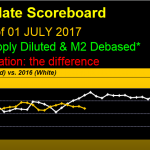 Image Source: Pixabay An IntroductionThe damage inflicted by cybercrime could reach as high as $10.29 trillion by 2025 (see report here) and, as such, sophisticated cyber security is crucial to protect networks, systems and other digital infrastructure from malicious attacks. That being said, only 10% of the security solutions market has currently been penetrated, with research (source) suggesting that a $2T – yes, trillion! – market exists for cyber security technology and service providers and that corporate spending on cybersecurity is forecast to grow at a CAGR of 13.8% between now and 2030 (source). Defining Pure-Play CompaniesAs the word conveys, pure-play companies concentrate all their efforts on a single line of business and, of the 63 cybersecurity companies in the sector (see here) only 7 are publicly traded pure-play companies.The Pure-Play CyberSecurity Software Stocks PortfolioShares of the 7 stocks in munKNEE’s Pure-Play CyberSecurity Software Stocks Portfolio plummeted 7.2% this week, primarily due to the weakness in the stock of cybersecurity software provider CrowdStrike (CRWD), a Portfolio constituent, which had already dropped 7.7% by the close on Thursday and was exacerbated on Friday by a further 11.3% decline as the result of a defective update being sent out by the company that caused a global IT outage for Microsoft (MSFT) Windows hosts. (Read: How the world’s tech crashed all at once)Below are how the 7 constituents performed this week, in descending order, along with their market capitalization, and the most recent news, analyses and commentary on some of them. While many fell in reaction to the midweek downgrade of CRWD, most recouped almost all their losses on Friday.
Image Source: Pixabay An IntroductionThe damage inflicted by cybercrime could reach as high as $10.29 trillion by 2025 (see report here) and, as such, sophisticated cyber security is crucial to protect networks, systems and other digital infrastructure from malicious attacks. That being said, only 10% of the security solutions market has currently been penetrated, with research (source) suggesting that a $2T – yes, trillion! – market exists for cyber security technology and service providers and that corporate spending on cybersecurity is forecast to grow at a CAGR of 13.8% between now and 2030 (source). Defining Pure-Play CompaniesAs the word conveys, pure-play companies concentrate all their efforts on a single line of business and, of the 63 cybersecurity companies in the sector (see here) only 7 are publicly traded pure-play companies.The Pure-Play CyberSecurity Software Stocks PortfolioShares of the 7 stocks in munKNEE’s Pure-Play CyberSecurity Software Stocks Portfolio plummeted 7.2% this week, primarily due to the weakness in the stock of cybersecurity software provider CrowdStrike (CRWD), a Portfolio constituent, which had already dropped 7.7% by the close on Thursday and was exacerbated on Friday by a further 11.3% decline as the result of a defective update being sent out by the company that caused a global IT outage for Microsoft (MSFT) Windows hosts. (Read: How the world’s tech crashed all at once)Below are how the 7 constituents performed this week, in descending order, along with their market capitalization, and the most recent news, analyses and commentary on some of them. While many fell in reaction to the midweek downgrade of CRWD, most recouped almost all their losses on Friday.
- Market Capitalization: $5B
- Most Recent News, Analyses, and Commentary:
- Tenable Launches Public Sector Advisory Board
- Market Capitalization: $16B
- Most Recent News, Analyses, and Commentary:
- Gen Launches Scam Artists to Highlight Emotional Toll of Cybercrime Through Creative Artwork
- Market Capitalization: $19B
- Most Recent News, Analyses, and Commentary:
- Check Point Named Leader in Mobile Threat Defense Solutions Report by Independent Research Firm
- Market Capitalization: $107B
- Most Recent News, Analyses, and Commentary:
- Is It Time To Consider Buying Palo Alto Networks?
- Market Capitalization: $45B
- Most Recent News, Analyses, and Commentary:
- Will Fortinet (FTNT) Beat Estimates Again in Its Next Earnings Report?
Zscaler (ZS): down 6.6% this week
- Market Capitalization: $28B
- Most Recent News, Analyses, and Commentary:
- Here’s Why Zscaler Stock Was Down 13% in the First Half of 2024
- Zscaler Could Be a Great Addition to Your Portfolio; Here’s Why
CrowdStrike Holdings (CRWD): down 17.9% this week
- Market Capitalization: $74B
- Most Recent News, Analyses, and Commentary:
- CrowdStrike Plunges Amid IT Outage As Financial Consequences Loom
- CrowdStrike ‘too critical a tool’ to cast off after outages
- Malicious actors posing as CrowdStrike employees or other tech specialists offering to assist those recovering from the outage
ConclusionOn average, the above 7 pure-play cybersecurity software stocks were down 7.2% this week but remain up 9.8% YTD.Cybersecurity ETFInvesting in a basket of cyber security stocks is a quick and easy way to get investment portfolio exposure to this critical segment of the tech sector. The Global X Cybersecurity ETF (BUG), for example, consists of 31 stocks and has an expense ratio of 0.51%.What is a Cyber Attack?Simply put, as you may well know, a cyber attack is any malicious attack on a computer system, network, or device to gain access and information. Cyber attecks take many forms such as:
- demand payment in exchange for access to that system (ransomware),
- covertly transmit information from the network (spyware), or
- install additional harmful software on the network.
It is estimated that cyber security spending was more than $188B in 2023 but cyber risk isn’t going away any time soon so it is imperative that companies keep up with the state of play and mitigate disruptions in the future.More By This Author:All 6 Semiconductor Segments Down 11%, On Average, This Week: Time To Buy In?
AI-Powered Drug Discovery Stocks Portfolio Up 14% MTD; Still Down 30% YTD
American Cannabis MSO Portfolio Went up 5% Last Week; Now +16% YTD









Leave A Comment